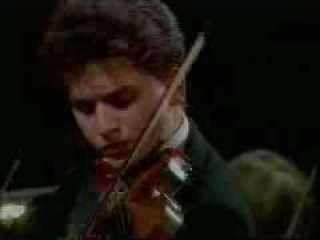Bartek Niziol plays Mozart (2012-13)
Bartek Niziol plays Mozart (2012-13)

Violin Concerto No. 5 in A major, K. 219 1.I Allegro aperto - Adagio - Allegro aperto (00:00) 2.II Adagio (10:04) 3.III Rondeau - Tempo di minuetto (21:03) Bartlomiej Niziol - violin Polish National Radio Symphony Orchestra Sir Neville Marriner – conductor Date of recording : 08.11.2013 Sinfonia Concertante for Violin, Viola and Orchestra in E-flat major, K. 364 (320d) 4.I Allegro maestoso, common time (31:27) 5.II Andante, 3/4, in C minor (44:14) 6.III Presto, 2/4 (54:37) Bartlomiej Niziol - violin David Greenlees - viola Cappella Istropolitana David Heer – conductor Date of recording : 17.02.2012
Each of Wolfgang Amadeus Mozart's successive violin concertos is longer and more epic than the one that preceded it, and by the time he reached the last of the authentic ones, the Violin Concerto No. 5 in A major, K. 219 (the "Turkish" Concerto), Mozart had managed to create something very nearly in line with the instrumental concerto of the next century. Though the piece itself is clearly within the Classical chamber concerto tradition, its scale (better than 25 minutes, usually) and the degree of its technical demands mark the work as something new for the violin. Many pieces with equal or greater raw physical demands had already been composed by the time of the Concerto No. 5, but none of them has survived the test of time, and certainly none is as formidable a piece of music -- it is not without reason that this is the only one of the five to regularly receive as much attention from musicologists and historians as do the crown jewels of Mozart's piano concerto catalog. A warhorse of the student repertory and a staple of the professional's diet, this may well be the most frequently played violin concerto ever written.
The dramatic scope of the Concerto No. 5 is truly impressive: it is very nearly an opera in concerto guise, with the soloist as protagonist. Mozart no longer asks the soloist to be content merely to slip into the first movement after the orchestra has made the requisite exposition of the main material, but instead actually stops the Allegro aperto movement altogether at the point of the solo violin entry and provides a wonderfully rich six-measure Adagio. The Allegro aperto almost immediately begins anew, but the fact that the solo violin had the power to halt the entire ensemble at so unlikely a juncture remains fresh in the mind throughout the rest of the concerto -- and it is worth noting that even as that Allegro aperto opening music takes off again, the violinist supplies a completely new melody, a high-flying, electrifying one, to go along with it.
The Adagio is a superb movement, longer by a considerable span than the slow movements of the previous four concertos. The melody tumbles along sublimely, and in the central portion we are treated to one of the most astoundingly beautiful passages ever conceived.
Mozart turns again to the French Rondo finale that he used in the third and fourth violin concertos for his third movement (Tempo di menuetto). In a French Rondo, the basic movement is interrupted in mid-stride by a section that contrasts with it in every way, and it is from this contrasting section -- a wild, frenzied Allegro -- that the "Turkish" Concerto gets its nickname. --- Blair Johnston, Rovi
The magnificent Sinfonia concertante for violin, viola, and orchestra in E flat major, K. 364, is Mozart's only surviving complete work of this type, a genre that incorporates elements of both the symphony and concerto. Generally scored for two or more solo instruments and orchestra, the sinfonia concertante was particularly popular in Paris in the eighteenth century. It was there, in fact, that Mozart composed such a work in 1778 for four outstanding wind soloists from the Mannheim orchestra who were also then in the French capital; that work, however, is now known only in a spurious nineteenthth century edition.
During this period Mozart also began two other works in the sinfonia concertante genre, one for violin and piano in D major (1778), and another for violin, viola and cello in A major, K. 320e (ca. 1779-1780), neither of which progressed beyond the first 130 or so measures before the composer set it aside. The present work may be a replacement for the aborted D major work. It was composed in Salzburg during the summer or fall of 1779, about the same time as that work. In both works, Mozart calls for a higher tuning than is usual for the viola; his purpose in so doing was undoubtedly to give the instrument a brighter sound to avoid being overshadowed by its more penetrating violin companion.
The soloists for whom the Sinfonia concertante was composed are not known, but they may have been Antonio Brunetti, the leader of the Salzburg court orchestra, and the violinist Joseph Hafender. The work is in three movements: Allegro maestoso, Andante and Rondo. The orchestra includes two oboes, two horns, an optional pair of bassoons, and strings. The work is notable for its warm expansiveness; the Andante is particularly delectable with its ravishing dialogue between the two soloists. The scoring is unusually full and rich; Mozart's frequent divisi writing for the violas produces textures that presage the sumptuous writing in Idomeneo, ré di Creta (1781), the opera seria composed for Munich less than a year later. --- Brian Robins, Rovi
download (mp3 @320 kbs):
uploaded yandex 4shared mega mediafire zalivalka cloudmailru uplea








